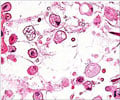The biological pathway that explains why Gaucher disease (GD) patients have a higher risk for developing Parkinson's disease (PD) has been identified.

GD is a hereditary disease in which the genes that encode the enzyme glucocerebrosidase are mutated, resulting in a life-threatening build-up of lipids, fatty substances, in cells. Previous studies have found that individuals born with two recessive GD gene mutations have a higher risk of developing PD than those with normal genes for the glucocerebrosidase enzyme. Even individuals who carry the GD mutation but who have no overt symptoms of the lipid storage disease have a higher risk for developing PD.
Mia Horowitz, Ph.D., and Galit Maor, Ph.D., of Tel Aviv University in Israel have built an accurate laboratory model in the fruit fly, Drosophila melanogaster, that traces the link between GD and PD through accumulations of defective copies of the enzyme. Their fruit fly with the mutated genes is the first animal model of GD with PD-like symptoms, according to the researchers.
Since the normal job of glucocerebrosidase is to chop up certain lipids, it might be expected that GD carriers would accumulate these lipids, but this is not the case, the researchers said. Instead, the problem seems to be caused by accumulation of the defective enzyme itself, leading to the activation of cellular machines that dispose of defective proteins. When these enzyme degradation machines get too busy, they can trigger a cascade that leads to cell death.
The death of specific cells in the brain, named dopaminergic cells, leads to development of PD. Dr. Horowitz hypothesized that this cell death cascade is the link to PD. Using the easily re-engineered fruit fly, Drs. Horowitz and Maor created a laboratory model of carriers of GD mutations to test their idea.
They mutated the GD enzyme, glucocerebrosidase, in a subset of neurons in the fruit flies. With defective glucocerebrosidases, the flies began losing their dopamine-generating neurons, a classic symptom of PD. Also, the fruitflies' reduced climbing ability is the fly equivalent of Parkinsonian hypokinesis, the characteristic movement "freeze-up" of patients with PD.
Advertisement
Source-Eurekalert









